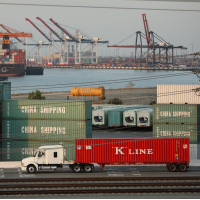Port of L.A. Didn’t Enforce “Green” Pollution Agreement after Expansion
 Port of Los Angeles (photo: David McNew, Getty Images)
Port of Los Angeles (photo: David McNew, Getty Images)
Until the Aliso Canyon natural gas reservoir sprung a leak two months ago and began pouring enormous amounts of methane into the Los Angeles region, the ports of Los Angeles and Long Beach were responsible for around 10% of Southern California’s smog-forming emissions.
Port pollution has been a longstanding problem and the source of much agitation. A groundbreaking accord was reached in 2003 to rein in pollutants at the Port of Los Angeles, and a new era of “green” operation—hailed by politicians, public health officials, business interests, environmentalists and nearby residents—was launched. It smoothed the way for a major expansion at the port.
Twelve years later, in September, the port conceded in a “notice of preparation of a draft environmental impact report” (pdf) that 11 of the 52 measures agreed to were not completed. Earlier in the week, the Los Angeles Times fleshed out a few of those shortfalls.
Tony Barboza reported that China Shipping North America, which operates a giant 130-acre terminal near Vincent Thomas Bridge, received a waiver from the port that let it ignore an agreement requiring ships to plug into on-shore electrical outlets instead of belching out pollutants while their diesel-engines idle. The waiver was issued shortly after an environmental impact report was approved for the terminal expansion in 2008.
The Times used the California Public Records Act to obtain documents detailing the waiver in 2009, which let China Shipping off the hook for a rule that required at least 70% of ships to plug in and shut down. “The Port will not hold China Shipping responsible for any outcome as a result of not meeting the 70 percent AMP requirement,” then-port Executive Director Geraldine Knatz wrote in a letter.
The port issued other waivers after regulations further tightened in 2011 until state regulators put a stop to it last year, the Times said. But, by then, plugins had dropped from 66% in 2011 to 12% in 2012 and more diesel fumes were billowing into some of the nation’s worst air. Compliance hit 98% in 2014 after state regulators said they had to hook up.
Other shortcomings at China Shipping were recorded by port employees but not acted upon. Some trucks and yard tractors that should have been switched to alternative fuels were not and ships that were supposed to slow down as they approached did not.
The Times said records showed China Shipping converted just 6% of the vehicles, a tad short of the required 70%. Requests by the Times for records and reports that China Shipping was to make public on a regular basis―as a condition of being allowed to expand the terminal―came up empty.
While impacted residents nearby and other interested parties ponder the trustworthiness of the corporate and governmental officials they strike bargains with over anti-pollution measures, port officials are making a big pitch to build a $500-million gateway rail yard and transit hub.
A coalition of local and environmental groups are seeking a court order to halt construction of the 153-acre port/Burlington Northern Santa Fe Railway Co. facility because they aren’t buying assurances that mitigation measures will actually decrease pollution in the area when trains and thousands of vehicles start shuttling to and from it.
Plaintiffs in the case include the Natural Resources Defense Council (NRDC), the California Attorney General’s office, the city of Long Beach, Long Beach Unified School District, the South Coast Air Quality Management District, East Yard Communities for Environmental Justice, the Coalition for Clean Air and Communities for a Safe Environment.
–Ken Broder
To Learn More:
The Port of L.A. Rolled Back Measures to Cut Pollution—During Its "Green" Expansion (by Tony Barboza, Los Angeles Times)
Environmentalists Ask Judge to Halt $500-Million Harbor-Area Rail Yard (by Dan Weikel, Los Angeles Times)
Port of Los Angeles Never Finished Landmark Pollution Controls (by Ken Broder, AllGov California)
- Top Stories
- Controversies
- Where is the Money Going?
- California and the Nation
- Appointments and Resignations
- Unusual News
- Latest News
- California Forbids U.S. Immigration Agents from Pretending to be Police
- California Lawmakers Urged to Strip “Self-Dealing” Tax Board of Its Duties
- Big Oil’s Grip on California
- Santa Cruz Police See Homeland Security Betrayal in Use of Gang Roundup as Cover for Immigration Raid
- Oil Companies Face Deadline to Stop Polluting California Groundwater





